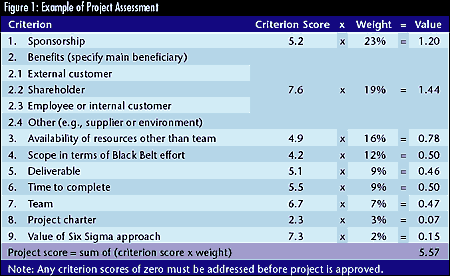Some of my previous columns have addressed the
issue of project selection from the organization's perspective (e.g., how to determine which projects should be funded when funds are limited). However, even when an enterprise puts together a
good portfolio of funded projects, there may be a shortage of another critical resource: the time of Six Sigma Black Belts. In many organizations, Black Belt time is a more severe
constraint than limited money. It seems there's no end to the list of potential projects--just the hours in a Black Belt's day. The same situation occurs for project sponsors, Green Belts and
team members. Thus, it's important that key players make certain that the projects they choose to pursue are good ones. But what exactly constitutes a "good" project? This
question can't be answered by running numbers through a computer simulation, although a computer can help get you there faster. The determination ultimately requires that someone make intelligent
and informed judgments. Following is a short version of a sample methodology that can be used to make these judgments. Figure 1 shows a set of criteria for assessing a Six Sigma
project, along with weights for each criterion. The weights are simply my own subjective assessment of the importance of each criterion. I arrived at these weights using a software package called
Expert Choice, which I've found to be very useful in converting subjective assessments to numerical values. Expert Choice uses the analytic hierarchical process method to convert pairwise
comparisons to weights that add to 100 percent. These weights can be used in various decision matrixes, such as the one shown in Figure 1, or in quality function deployment.
 |
Figure 1 is used by assigning a score of zero to nine to each criterion. The criterion scores are then multiplied by the weights and added together to get a total score for
the project. Project scores can range from zero to nine. Keep in mind that the numeric project score isn't as important as how it compares to other project scores.
Ideally there will be a point where some projects are clearly better than others, allowing Black Belts to pursue those projects.
To use Figure 1, you need to develop guidelines for assigning scores to each criterion. The guidelines just need to make sense for you and your organization. The
numerical scale need not be zero to nine; however, I recommend using the same numerical scale for every criterion. Using a different numerical scale amounts to
changing the weights. Figure 2 presents an example of how guidelines might look.
This approach borrows elements from QFD and decision making. It isn't perfect, but it will serve the purpose of distinguishing good prospects from real duds. The
inevitable projects remaining in the gray area can be examined more closely once the cherries have been picked. But by that time, there are usually more cherries on the tree. About the author Thomas Pyzdek is a consultant in Six Sigma. He has written more than 50 books
and software and training products, including The Six Sigma Handbook (McGraw-Hill, 2000). Learn more about Six Sigma at www.pyzdek.com . E-mail
Pyzdek at Tom Pyzdek . |